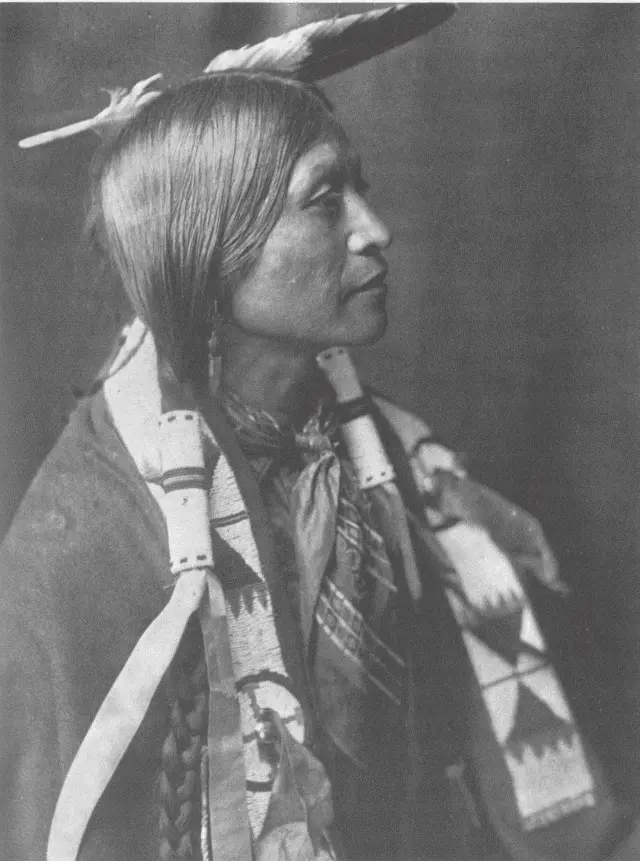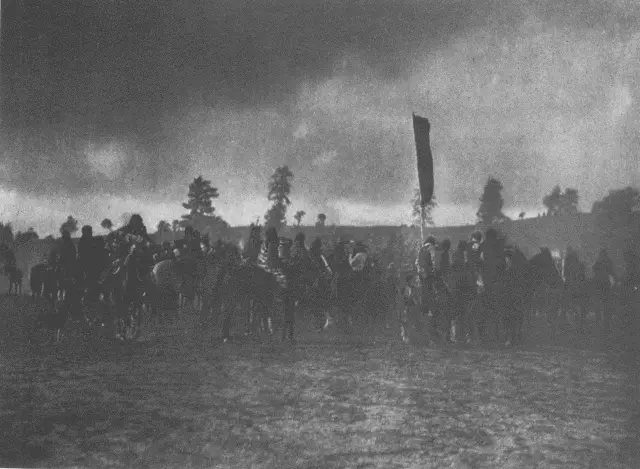
A Jicarilla
Owing to their composite nature the Jicarillas are a peculiarly interesting group. Too small in numbers to resist the cultural influence of other tribes, and having been long in contact with the buffalo hunters of the great plains as well as in close touch with the pueblo of Taos with its great wealth of ceremony and ritual, it is not surprising that the Jicarillas, in life and ceremony, have been deeply influenced by adjacent tribes. As previously stated, the Jicarilla medicine rites are much like those of the Navaho, but are far simpler in character. In dress the Jicarillas resemble the Indians of the plains, even to the feather headdress, which is never worn by the tribes to their south and west. Features of an annual fiesta have been borrowed directly from the Pueblos.
The typical habitation of the Jicarillas is a tipi, or lodge, called kozhán, patterned after that of the Plains tribes. Formerly they hunted the buffalo, making periodical excursions from their mountain home to the plains and bringing back quantities of prepared meat and large numbers of hides, which were fashioned into tents and used for many other purposes. To all intents and purposes, therefore, the Jicarillas were a plains tribe. Only within recent years have they grown crops of any kind. They exhibit fair skill in basketry, this being their chief industry and source of barter with neighboring tribes; indeed it was through this custom of making "little baskets" that the Spaniards applied to them the name by which they are popularly known. The Pueblos of the Rio Grande use many baskets, which they obtain chiefly from the Jicarillas in exchange for corn. During late years many of these jicarillas have been disposed of to traders. Like the Navaho they make but little pottery, and that only for utilitarian purposes.
The Jicarillas seem to have no system of clans or gentes. The tribe is divided into two bands—commonly called by their Spanish names, Olleros (Potters) and Llaneros (Plainsmen)—within which marriage is not prohibited. In the days of the buffalo a part of the tribe, preferring the prairie country, remained there for a short time and received the name Kolhkahín, People of the Plains. The others returned to the mountains and from the pottery they there made were called Sait Ndĕ, Sand People, sand being used in mixing the clay. In event of marriage between members of different bands, sons born of the union belong to the father's band, while daughters belong to the band of the mother.
Generally speaking, chieftainship is hereditary, passing to the eldest son, if there be such, otherwise to a brother, on the death of the incumbent; but this rule might be set aside if public opinion were strong enough to warrant it, and the chief be selected from another family. Each band has a headman, chosen by reason of his personal bravery and worthiness. The tribal chief, however, is the recognized leader, the two band chiefs being little more than figureheads.
The social customs of the Jicarillas are well defined. A young man wishing to marry sends a near relation to procure the consent of the girl's parents, with whose decision the wishes of the daughter have little weight. If the young man meets their approval, he is sent out to hunt, and the game which he kills is distributed among the girl's relations. The following day his family build a kozhán and place in it the personal effects of the young couple, who, at night, enter with friends and kinsfolk. A medicine-man prays to Nayé̆nayĕzganĭ, asking his beneficence toward the new home. This ceremony lasts until midnight, when the visitors depart and the marriage is consummated. Polygamy was common. Divorce is effected without ceremony, the discontented one deserting the other and leaving him or her in possession of the dwelling.
Property right is governed by tribal laws. The wife's belongings are inherited by her children or, if she should have none, by her parents, not by the husband. On the death of the husband his property passes to the children and the wife.
The dead are buried in secret, only a few of the close relations having knowledge of the place. Immediately after death the body is carried on horseback to a high point, where it is placed on the ground and covered with the personal possessions of the deceased, such as clothing, blankets, saddles, and weapons, and over all are heaped brush and stones. Formerly a man's horse was killed near his grave, and sometimes as many as three or four horses were similarly sacrificed at different places. In former times also the kozhán was burned after the burial, and members of the family cut their hair as a sign of mourning. The souls of the dead are believed to rise skyward. In one portion of the sky, among vast herds of buffalo, all those who have met death in battle assemble, rich and happy; in another part, those who have succumbed to sickness and old age. The evil, or those who have practised witchcraft, have a place apart from the rest. Between the latter and the spirits of the good stands a high rock wall at which the evil ones are condemned to dig for eternity in an effort to reach the happier home. Spirits can work only in darkness, and the work of the night is ever brought to naught by recurring daylight.

A Jicarilla Feast March
The Jicarillas, like their kindred the Navaho and Apache, pay much attention to religion and ceremony. Compared with the Navaho their life seems almost lacking in ceremony, but when contrasted with the various Yuman tribes on the Colorado and Gila rivers of Arizona it is fairly rich. Their healing or medicine rites include a dance, called Isánĕ, that occupies four days and four nights, and many one-day "sings," in all of which dry-paintings are employed. Like the Apache the Jicarillas attach much importance to the girls' puberty ceremony and still rigidly adhere to it.
A four-day medicine dance is founded on the following legend:
Two maidens lived at the bottom of a deep pit. Many of the men wished to marry them, but the girls were well content and refused to come out. The Bear and the Snake formed a plan to carry them off and make them their wives. A beautiful butterfly was sent fluttering down over the girls' heads, but they paid little heed to its beauties. Another was sent, then another, and yet a fourth, which was so beautiful that the girls reached up to catch it, for they wished to copy its splendid colors on a large basket they were weaving. But the butterfly escaped them and flew upward, keeping ever out of reach as the girls followed to the mouth of the pit. There the Bear and the Snake in waiting suddenly reached over, seized the girls, and carried them away. The people, learning of this, asked them to bring the girls back, but the Bear and the Snake refused, so an appeal was made to Nayé̆nayĕzganĭ and Kobadjischínĭ. These two gods built a fence around the world to keep the Bear and the Snake from escaping, and, summoning all the people, compelled the Bear and the Snake to bring the two young women back. The one the Bear had married had grown very fat and coarse, like her master. "What have you done to make this girl so fat?" demanded Nayé̆nayĕzganĭ in anger. "You must give her medicine to make her comely again." So the Bear sang songs and made medicine until the girl was herself again. Then came the Snake with the girl he had stolen. She had become thin, like her master. "What have you done to make this girl so thin?" cried Nayé̆nayĕzganĭ. "You must give her medicine to make her well again." The Snake then sang his songs and made medicine until the girl became again robust and beautiful.
Читать дальше














